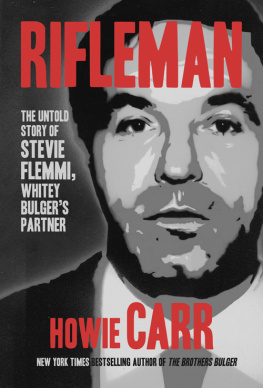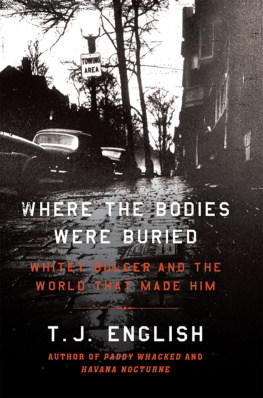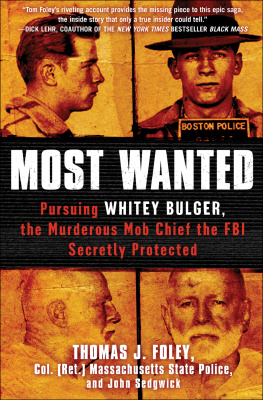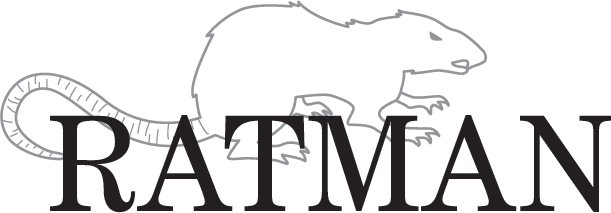The Trial and Conviction of Whitey Bulger
HOWIE CARR
Frandel, LLC
Copyright 2013, Howie Carr
ISBN: 978-0-9860372-3-8 (hardcover)
ISBN: 978-0-9860372-6-9 (paperback)
ISBN: 978-0-9860372-4-5 (epub)
ISBN: 978-0-9860372-5-2 (epdf)
Library of Congress Control Number: 2013951003
All Rights Reserved. No part of this book may be reproduced or transmitted in any form or by any means, electronic or mechanical, including photocopying, recording, or by any information storage and retrieval system without written permission from the author, except for the inclusion of brief quotations in a review.
Printed in the United States of America.
Table of Contents
Acknowledgments
So many people contributed to the production of this book in such a short amount of time that I hope I dont miss thanking anyone who should be included in this brief list.
First of all, my wife Kathy, who handled all the production detailsthe partnership with Bookmasters, cover design, new magnets, the book-signing schedule, etc. If youre gettingor givingthis book as a Christmas present, think of Kathy. Without her prodding and pushing, this book might have made a perfect giftfor Fathers Day.
My three daughtersCarolyn, Charlotte and Tinaall helped their computer-challenged father in varying amounts, with varying amounts of snide remarks about my Stone Age ways.
Outside of the family, I certainly owe most to my radio producer, Nancy Sandy Shack, who kept track of an immense amount of exhibits, mainly photographs, that arrived daily from the courthouse. She also deciphered my scribbling and made sure every picture ended up where it belonged in the text. I cant thank you enough, Sandy.
Mark Garfinkel, the Boston Heralds great photographer, is responsible for most of the photographs in Ratman that were taken outside the courthouse. I thank Mark and his fellow Herald photographers, who sometimes took such riveting photos that my column in the newspaper the next morning was superfluous. (Im thinking Kevin ONeil.) Also at the Herald, thanks to head photographers Jim Mahoney and Arthur Pollock, who tracked down my ancient mug shots, and head librarian Martha Reagan, who almost always found the obscure, 50-year-old clipping that Id requested.
Thanks too to the Heralds publisher Pat Purcell, editor Joe Sciacca and managing editor John Strahinich for running such a great paper that I could spend most of the summer on basically one subject, day after day after day. And when I couldnt make it to court, Herald reporter Laurel J. Sweet always kept me up-to-date with her notes.
Another Herald stalwart, Tyrell Adamson, produced a great cover, working with the three traditional true-crime colors, red, white and black.
Sincere gratitude goes to Anthony Amore of the Isabella Stewart Gardner Museum, who read behind me and served as a kind of line editor. I appreciate Christina Sterling from the U.S. Attorneys office for her prompt daily delivery of all the latest exhibits, and for a phone call one Friday night in June that I will always remembertelling me that as one of Whiteys defense witnesses I was now sequestered, i.e., banned from the courtroom. (Thank you, Judge Casper, for letting me back in on Monday morning.) Thanks also to professional proofreader and technical editor Wes Wilson for editing the galleys one final time before Ratman went to press.
Thanks too to all my radio affiliates that supported my Night of Crime tour, which served as a launching pad for both Rifleman and Ratman. Cary Pahigian, Jeff Wade, and Warren Maddock at WGAN, Sean Davey at WHYN, Sheila and Bob Vinikoor at WNTK, Bruce Biette at WVOM, Kurt Carberry at WCRN, Bob Cox at WKBK and Allison Makkay Davis at WXTKI trust well all continue to be together, well into the future.
At Bookmasters, I couldnt ask for a better project director than Jen Welsch. Her turnaround time is astonishing. Thanks also to Ray Sevin, who keeps the schedule running smoothly, Tony Proe and Jon Ackerman in sales, and our customer services rep, Elaine Lattanzi. Mike Dever is a master of production; his skill is the reason youre holding this book in your hands so soon after the trial.
As always, many others helped out, but it would be doing them a disservice to name them. Those are my sources.
So this is it, the end of a long run, sometimes scary, more often fun (especially after Ratman went on the lam). If you want to know more about the other books (theyre all still in print) go to my website howiecarrshow.com. I hope you enjoy this fourth and final volume of the series, and Ill end with the two words that I originally wanted to use as the title of this book:
Goodbye, Whitey.
Howie Carr
Prologue
Whitey with James Stephen Martorano
T HIS IS JAMES J. Whitey Bulger, Jr. in 1986, at the height of his underworld career, a literal godfather for the youngest son of his underworld partner John Martorano. This photo was taken at St. Clements Church in Somerville, or, as Martorano nonchalantly described it at Whiteys trial, somewhere in Boston.
Johnnythe Cook, as Whitey called himhad named his infant son James Stephen: James after Whitey and Stephen after Stevie the Rifleman Flemmi. They were the three remaining partners in the Winter Hill Gang, of which Whitey had become the dominant member.
Overbearing, Flemmi would describe Whitey in court in 2013.
His job in the gang? Intimidation, mostly, Martorano would say in court in 2008.
But in 1986, Whitey was on top o the world, Ma, top o the world, as his cinematic hero Jimmy Cagney put it in White Heat. His younger brother Billy was the most powerful politician in the state; when a colonel in the State Police put a bug in Whiteys garage, an anonymous rider was quickly added to the state budget to force his retirement. Another state cop who stopped Whitey from taking cash out of the country at Logan Airport was summarily transferred to the sticks after the cop refused to hand over his police report to the head of the airport, an appointee of the 1988 Democratic nominee for president, Gov. Michael S. Dukakis.
Whitey was the biggest cocaine dealer in his hometown of South Boston, if not the entire city, yet the Boston Globes columnists insisted that he had kept the drugs out of Southie.
He had six FBI agents on his payroll, not to mention untold local cops. He was making so many payoffs to the police that he coined a saying that would become famous in Boston in the years ahead:
Christmas is for cops and kids.
The cops came in handy. Gangsters have always shaken down other criminals, but in Whitey Bulgers Boston, even law-abiding citizens had nowhere to turn when they found Whitey pointing a gun at them. One businessman, Michael Solimando, a partner of one of the gangs murder victims, was summoned to Whiteys bar in the Lower End in 1982. Whitey demanded $400,000 that he falsely claimed he was owed by the murdered businessman. Whitey pointed a gun at Solimandos head, then put the gun down and grabbed a machine gun and shoved it into his victims crotch.
As Solimando recalled in August 2013:
He said, you know, If you think you couldif youre going to law enforcement, he said, were going to know the minute you walk on the 14th floor of the Federal building. Were going to know about it. And if you think youre going to go to the State Police, forget about it. Were covered there. And forget about the Boston P.D. Were going to know. Were going to know the minute you open your mouth. And what were going to do is get a hat, put three names it, all right? And were going to pull one name, all right, and that guys going to be dead. And then well see how fast the other two come up with the money.











